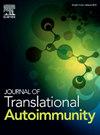酰基肉碱富集作为类风湿关节炎成纤维细胞样滑膜细胞代谢指纹的特征
IF 3.6
Q2 IMMUNOLOGY
引用次数: 0
摘要
目的在类风湿关节炎(RA)中,成纤维细胞样滑膜细胞(FLS)改变其代谢以支持其活化。我们旨在通过在RA FLS与非炎症FLS (NI)中进行非靶向代谢组学分析与RA相关的全谱代谢改变。方法采用质谱法对来自随机对照NORD-STAR试验的早期RA患者的10个原发RA和7个NI FLS培养提取物和220个血清样本进行靶向注释代谢组学分析。Western blot检测肉毒碱相关蛋白。用海马通量分析仪评估FLS生物能量谱。结果基于138个注释代谢物的代谢组学分析显示RA和NI FLS之间具有明显的代谢指纹图谱。在RA FLS富集的12种代谢物中,有11种是酰基肉碱。NI FLS的促炎刺激也导致酰基肉碱积累。与NI FLS相比,RA FLS的脂肪酸转运蛋白CD36水平较低,但左旋肉碱转运蛋白和左旋肉碱棕榈酰基转移酶1a和2水平相似。海马分析显示,RA和NI FLS脂肪酸氧化无差异;然而,RA FLS表现出线粒体功能障碍和能量损伤。在甲氨蝶呤联合阿巴接受或托珠单抗治疗24周后,早期RA患者的血清酰基肉碱含量下降。结论酰基肉碱积累是RA FLS代谢指纹图谱的特征,可能与线粒体功能障碍有关。在早期RA患者中,抗风湿治疗成功后,血清中酰基肉碱含量降低。这些结果表明RA在关节水平和全身水平上的酰基肉碱代谢失调。本文章由计算机程序翻译,如有差异,请以英文原文为准。
Acylcarnitine enrichment as a characteristic of rheumatoid arthritis fibroblast-like synoviocyte metabolic fingerprint
Objective
In rheumatoid arthritis (RA), fibroblast-like synoviocytes (FLS) alter their metabolism to support their activation. We aimed to analyse the full spectrum of metabolic alterations associated with RA by performing untargeted metabolomics in RA FLS vs. non-inflamed (NI) FLS.
Methods
Untargeted annotated metabolomics was performed using mass spectrometry on ten primary RA and seven NI FLS culture extracts and 220 serum samples from participants with early RA from the randomised controlled NORD-STAR trial. Carnitine-related proteins were measured with Western blot. FLS bioenergetic profile was assessed with a Seahorse flux analyser.
Results
Metabolomics analysis based on 138 annotated metabolites revealed a distinct metabolic fingerprint between RA and NI FLS. Of the 12 metabolites enriched in RA FLS, 11 were acylcarnitines. Pro-inflammatory stimulation of NI FLS also led to acylcarnitine accumulation. RA FLS exhibited lower levels of CD36, a fatty acid transporter, but similar levels of L-carnitine transporter, and carnitine palmitoyltransferase 1 A and 2 compared to NI FLS. Seahorse analyses showed no difference in fatty acid oxidation between RA and NI FLS; however, RA FLS displayed mitochondrial dysfunction and energetic impairment. Serum acylcarnitine content decreased after 24 weeks of treatment with methotrexate combined with abatacept or tocilizumab in patients with early RA achieving remission.
Conclusion
Acylcarnitine accumulation is a characteristic of RA FLS metabolic fingerprint and could be linked to mitochondrial dysfunction. In patients with early RA, acylcarnitine content in serum decreases after successful anti-rheumatic treatment. These results indicate a dysregulation in acylcarnitine metabolism in RA at the joint level and systemically.
求助全文
通过发布文献求助,成功后即可免费获取论文全文。
去求助
来源期刊

Journal of Translational Autoimmunity
Medicine-Immunology and Allergy
CiteScore
7.80
自引率
2.60%
发文量
33
审稿时长
55 days
 求助内容:
求助内容: 应助结果提醒方式:
应助结果提醒方式:


